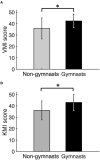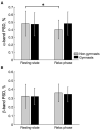Gymnasts' Ability to Modulate Sensorimotor Rhythms During Kinesthetic Motor Imagery of Sports Non-specific Movements Superior to Non-gymnasts
- PMID: 34805979
- PMCID: PMC8600039
- DOI: 10.3389/fspor.2021.757308
Gymnasts' Ability to Modulate Sensorimotor Rhythms During Kinesthetic Motor Imagery of Sports Non-specific Movements Superior to Non-gymnasts
Abstract
Previous psychological studies using questionnaires have consistently reported that athletes have superior motor imagery ability, both for sports-specific and for sports-non-specific movements. However, regarding motor imagery of sports-non-specific movements, no physiological studies have demonstrated differences in neural activity between athletes and non-athletes. The purpose of this study was to examine the differences in sensorimotor rhythms during kinesthetic motor imagery (KMI) of sports-non-specific movements between gymnasts and non-gymnasts. We selected gymnasts as an example population because they are likely to have particularly superior motor imagery ability due to frequent usage of motor imagery, including KMI as part of daily practice. Healthy young participants (16 gymnasts and 16 non-gymnasts) performed repeated motor execution and KMI of sports-non-specific movements (wrist dorsiflexion and shoulder abduction of the dominant hand). Scalp electroencephalogram (EEG) was recorded over the contralateral sensorimotor cortex. During motor execution and KMI, sensorimotor EEG power is known to decrease in the α- (8-15 Hz) and β-bands (16-35 Hz), referred to as event-related desynchronization (ERD). We calculated the maximal peak of ERD both in the α- (αERDmax) and β-bands (βERDmax) as a measure of changes in corticospinal excitability. αERDmax was significantly greater in gymnasts, who subjectively evaluated their KMI as being more vivid in the psychological questionnaire. On the other hand, βERDmax was greater in gymnasts only for shoulder abduction KMI. These findings suggest gymnasts' signature of flexibly modulating sensorimotor rhythms with no movements, which may be the basis of their superior ability of KMI for sports-non-specific movements.
Keywords: athletes; electroencephalogram (EEG); event-related desynchronization (ERD); kinesthetic motor imagery (KMI); the Kinesthetic and Visual Imagery Questionnaire (KVIQ).
Copyright © 2021 Sugino and Ushiyama.
Conflict of interest statement
The authors declare that the research was conducted in the absence of any commercial or financial relationships that could be construed as a potential conflict of interest.
Figures





Similar articles
-
Subjective Vividness of Kinesthetic Motor Imagery Is Associated With the Similarity in Magnitude of Sensorimotor Event-Related Desynchronization Between Motor Execution and Motor Imagery.Front Hum Neurosci. 2018 Jul 31;12:295. doi: 10.3389/fnhum.2018.00295. eCollection 2018. Front Hum Neurosci. 2018. PMID: 30108492 Free PMC article.
-
Experience-dependent modulation of alpha and beta during action observation and motor imagery.BMC Neurosci. 2017 Mar 6;18(1):28. doi: 10.1186/s12868-017-0349-0. BMC Neurosci. 2017. PMID: 28264664 Free PMC article.
-
Ipsilateral EEG mu rhythm reflects the excitability of uncrossed pathways projecting to shoulder muscles.J Neuroeng Rehabil. 2017 Aug 25;14(1):85. doi: 10.1186/s12984-017-0294-2. J Neuroeng Rehabil. 2017. PMID: 28841920 Free PMC article.
-
How Kinesthetic Motor Imagery works: a predictive-processing theory of visualization in sports and motor expertise.J Physiol Paris. 2015 Feb-Jun;109(1-3):53-63. doi: 10.1016/j.jphysparis.2015.02.003. Epub 2015 Mar 25. J Physiol Paris. 2015. PMID: 25817985 Review.
-
ERD/ERS patterns reflecting sensorimotor activation and deactivation.Prog Brain Res. 2006;159:211-22. doi: 10.1016/S0079-6123(06)59014-4. Prog Brain Res. 2006. PMID: 17071233 Review.
Cited by
-
The Acute Effects of Motor Imagery Combined With Action Observation Breathing Exercise on Cardiorespiratory Responses, Brain Activity, and Cognition: A Randomized, Controlled Trial.Cardiovasc Ther. 2025 Feb 22;2025:6460951. doi: 10.1155/cdr/6460951. eCollection 2025. Cardiovasc Ther. 2025. PMID: 40026414 Free PMC article. Clinical Trial.
References
LinkOut - more resources
Full Text Sources

